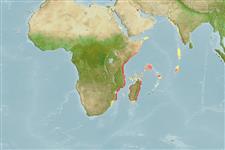>
Acanthuriformes (Surgeonfishes) >
Leiognathidae (Slimys, slipmouths, or ponyfishes) > Gazzinae
Etymology: squamiventralis: Named for the scalation of this species..
Environment: milieu / climate zone / depth range / distribution range
Ecologia
marino; distribuzione batimetrica 4 - 13 m (Ref. 39894). Tropical
Distribuzione
Stati | Aree FAO | Ecosystems | Presenze | Point map | Introduzioni | Faunafri
Western Indian Ocean: along the east coast of Africa from Kenya to Mozambique.
Size / Peso / Age
Maturity: Lm ? range ? - ? cm
Max length : 9.6 cm SL maschio/sesso non determinato; (Ref. 39894)
Short description
Morfologia | Morfometria
Spine dorsali (totale): 8; Raggi dorsali molli (totale): 16; Spine anali 3; Raggi anali molli: 14; Vertebre: 24. The ventrolateral surface of the body scaled anterior to a line from pectoral fin base to pelvic fin origin. Smooth supraorbital ridge (Ref. 39894).
Nothing is known on its ecology except specimens were collected from coastal waters shallower than about 13 m depth along with Gazza minuta (Ref. 39894).
Life cycle and mating behavior
Maturità | Riproduzione | Deposizione | Uova | Fecundity | Larve
Yamashita, T. and S. Kimura, 2001. A new species, Gazza squamiventralis, from the East coast of Africa (Perciformes: Leiognathidae). Ichthyol. Res. 48(2):161-166. (Ref. 39894)
IUCN Red List Status (Ref. 130435)
Threat to humans
Harmless
Human uses
Informazioni ulteriori
StatiAree FAOEcosystemsPresenzeIntroduzioniStocksEcologiaDietaPredeConsumo di ciboRazione
Nomi ComuniSinonimiMetabolismoPredatoriEcotossicologiaRiproduzioneMaturitàDeposizioneSpawning aggregationFecundityUovaEgg development
Age/SizeAccrescimentoLength-weightLength-lengthLength-frequenciesMorfometriaMorfologiaLarveDinamica popolazioni larvaliReclutamentoAbbondanzaBRUVS
BibliografiaAcquacolturaProfilo di acquacolturaVarietàGeneticaElectrophoresesEreditarietàMalattieElaborazioneNutrientsMass conversion
CollaboratoriImmaginiStamps, Coins Misc.SuoniCiguateraVelocitàModalità di nuotoArea branchialeOtolithsCervelliVista
Strumenti
Special reports
Download XML
Fonti Internet
Estimates based on models
Preferred temperature (Ref.
123201): 25.7 - 28.1, mean 27 °C (based on 114 cells).
Phylogenetic diversity index (Ref.
82804): PD
50 = 0.5312 [Uniqueness, from 0.5 = low to 2.0 = high].
Bayesian length-weight: a=0.01862 (0.00823 - 0.04215), b=2.97 (2.78 - 3.16), in cm total length, based on LWR estimates for this (Sub)family-body shape (Ref.
93245).
Trophic level (Ref.
69278): 3.0 ±0.4 se; based on size and trophs of closest relatives
Resilienza (Ref.
120179): Alto, tempo minimo di raddoppiamento della popolazione meno di 15 mesi (Preliminary K or Fecundity.).
Fishing Vulnerability (Ref.
59153): Low vulnerability (10 of 100).
